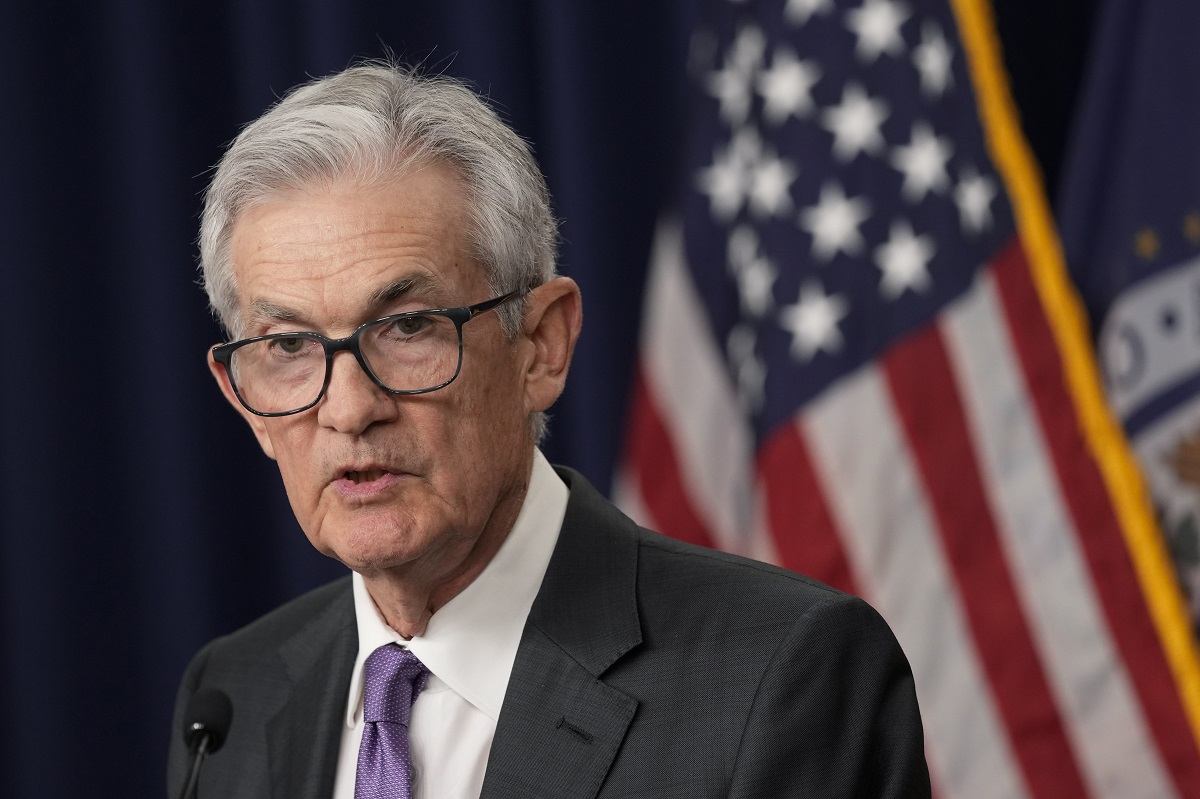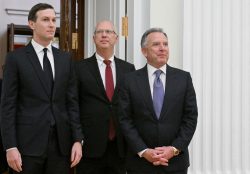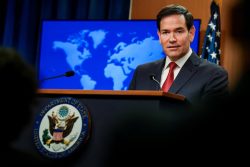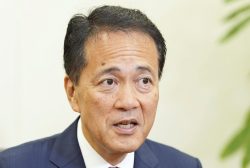Federal Reserve Still Foresees 3 Interest Rate Cuts This Year Despite Bump in Inflation

Federal Reserve Board Chair Jerome Powell speaks during a news conference the Federal Reserve in Washington, Wednesday, March 20, 2024.
12:16 JST, March 21, 2024
WASHINGTON (AP) — Federal Reserve officials signaled Wednesday that they still expect to cut their key interest rate three times in 2024, fueling a rally on Wall Street, despite signs that inflation remained elevated at the start of the year.
For now, the officials kept their benchmark rate unchanged for a fifth straight time.
Speaking at a news conference, Chair Jerome Powell said the surprising pickup in inflation in January and February hadn’t fundamentally changed the Fed’s picture of the economy: The central bank still expects inflation to continue to cool, though more gradually than it thought three months ago.
The January and February data, Powell said, “haven’t really changed the overall story, which is that of inflation moving down gradually on a sometimes bumpy road towards 2%,” the Fed’s target.
The recent high inflation readings followed six months of steady slowdowns in price increases. Economists and Wall Street investors were looking for some clarification Wednesday about how the latest inflation reports were viewed at the Fed.
In new quarterly projections they issued, the policymakers forecast that stronger growth and inflation above their 2% target level would persist into next year. Overall, the forecasts suggest that the Fed still expects an unusual combination: A healthy job market and economy in tandem with inflation that continues to cool — just more gradually than they had predicted three months ago.
For this year, the Fed projected that the economy will expand 2.1% — a big increase from its December forecast of just 1.4%. Yet at the same time, it still expects inflation to keep declining, though slowly.
Michael Gapen, chief U.S. economist at Bank of America, said the Fed’s updated projections suggest that it expects improvements in supply chains and the availability of workers to continue, allowing the economy to grow even as inflation slows to the Fed’s target. Rising immigration, for example, has made it easier for businesses to hire without having to rapidly raise pay.
“It looks to me like they’re embracing that supply-side story,” Gapen said. That means “you can cut while growth is solid, and you can cut while the labor market is strong.”
Rate cuts would, over time, lead to lower costs for home and auto loans, credit card borrowing and business loans. They might also aid President Joe Biden’s re-election bid, which is facing widespread public unhappiness over higher prices and could benefit from an economic jolt stemming from lower borrowing rates.
The financial markets cheered the message Wednesday from Powell and the Fed, with traders sending the Dow Jones industrial average surging 1%, to another all-time high.
“Inflation has come way down, and that gives us the ability to approach this question carefully and feel more confident that inflation is moving down sustainably,” Powell said. “It is still likely … that we will see that confidence and that there will be rate cuts.”
The Fed’s policymakers did make some small adjustments in their outlook: Their projections showed that in 2025, they now foresee only three rate cuts, down from the four they envisioned in their December forecasts.
One reason may be that they expect “core” inflation, which excludes volatile food and energy costs, to still be 2.6% by the end of 2024, up from their previous projection of 2.4%. In January, core inflation was 2.8%, according to the Fed’s preferred measure.
The Fed’s foecasts overall, suggest that
Most economists have pegged the Fed’s June meeting as the most likely time for it to announce its first rate cut, which would begin to reverse the 11 hikes it imposed beginning two years ago. The Fed’s hikes have helped lower annual inflation from a peak of 9.1% in June 2022 to 3.2%. But they have also made borrowing much costlier for businesses and households.
Though consumer inflation has tumbled since mid-2022, it has remained stuck above 3%. And in the first two months of 2024, the cost of services, like rents, hotels and hospital stays, remained elevated. That suggested that high borrowing rates weren’t sufficiently slowing inflation in the economy’s vast service sector.
While the Fed’s rate hikes typically make borrowing more expensive for homes, cars, appliances and other costly goods, they have much less effect on services spending, which doesn’t usually involve loans. With the economy still healthy, there is no compelling reason for the Fed to cut rates until it feels inflation is sustainably under control.
“There’s no urgency for them,” said Luke Tilley, chief economist at Wilmington Trust, a wealth management company. “They’ve got a strong economy, strong labor market.”
In most respects, the U.S. economy remains heathy. Employers keep hiring, unemployment remains low, and the stock market is hovering at record highs. Yet average consumer prices remain much higher than they were before the pandemic — a source of unhappiness for many Americans for which Republicans have sought to pin blame on Biden.
And there are signs that the economy could weaken in the coming months. Americans slowed their spending at retailers in January and February, for example. The unemployment rate has reached 3.9% — still a healthy level, but up from a half-century low last year of 3.4%. And much of the hiring in recent months has occurred in government, health care and private education, with many other industries barely adding any jobs.
Other major central banks are also keeping rates high to ensure that they have a firm handle on consumer price spikes. In Europe, pressure is building to lower borrowing costs as inflation drops and economic growth stalls. The European Central Bank’s leader hinted this month that a possible rate cut could come in June, while the Bank of England isn’t expected to open the door to any imminent cut when it meets Thursday.
"News Services" POPULAR ARTICLE
-

American Playwright Jeremy O. Harris Arrested in Japan on Alleged Drug Smuggling
-

Japan’s Nikkei Stock Average as JGB Yields, Yen Rise on Rate-Hike Bets
-

Japan’s Nikkei Stock Average Licks Wounds after Selloff Sparked by BOJ Hike Bets (UPDATE 1)
-

Japan’s Nikkei Stock Average Buoyed by Stable Yen; SoftBank’s Slide Caps Gains (UPDATE 1)
-

Japanese Bond Yields Zoom, Stocks Slide as Rate Hike Looms
JN ACCESS RANKING
-

Keidanren Chairman Yoshinobu Tsutsui Visits Kashiwazaki-Kariwa Nuclear Power Plant; Inspects New Emergency Safety System
-

Imports of Rare Earths from China Facing Delays, May Be Caused by Deterioration of Japan-China Relations
-

Tokyo Economic Security Forum to Hold Inaugural Meeting Amid Tense Global Environment
-

University of Tokyo Professor Discusses Japanese Economic Security in Interview Ahead of Forum
-

Japan Pulls out of Vietnam Nuclear Project, Complicating Hanoi’s Power Plans


























